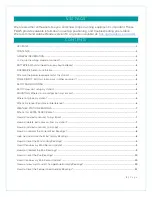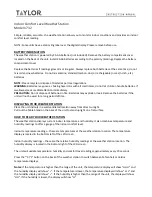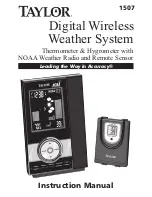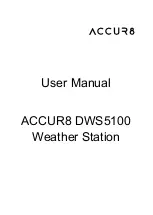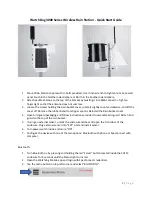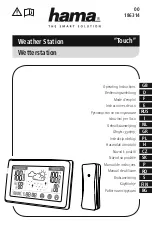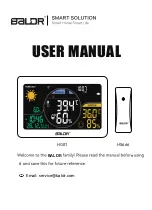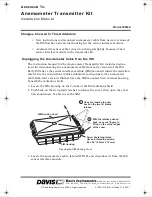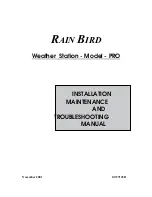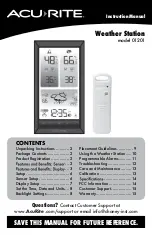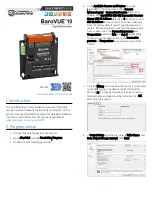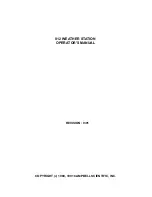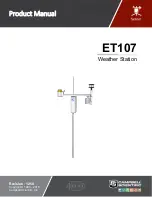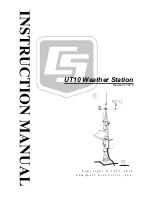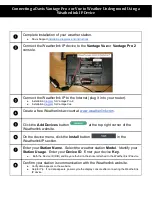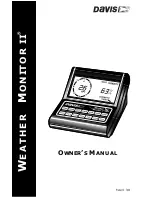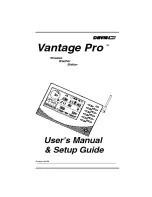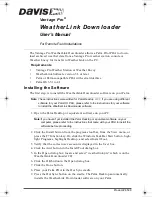
A. LED INDICATOR
•
Flashes once when the remote sensor
transmits a reading to the main unit.
•
Flashes twice when battery power is low.
B. BATTERY COMPARTMENT
Holds 2 “AA” batteries
C. RESET
Resets all readings
D. CHANNEL SWITCH
Selects the desired transmission channel
from 1 to 3
E. WALL-MOUNT RECESSED OPENING
Attaches the remote sensor to the wall
NOTE:
Install the batteries and select the channel before mounting the sensor.
BATTERY INSTALLATION
•
Remove the screws from the battery compartment with a small Phillips screwdriver.
•
Set the channel 1 through 3. The switch is located in the battery compartment. Channel 1 is
typically selected if only one remote sensor is being used.
•
Install 2 “AA” batteries (not included) matching the polarities shown in the battery compartment.
•
Replace the battery compartment door and secure the screws.
•
Secure the thermo-hygrometer remote sensor in the desired location.
MOUNTING
•
The remote thermo-hygrometer sensor can be placed on the flat surface or mounted on the wall in
vertical position.
•
Use the wall mount hardware and screws provided when mounting the thermo-hygrometer sensor
on the wall.
PLACEMENT TIPS:
•
The remote thermo-hygrometer sensor should be placed in the area with a free air circulation and
sheltered from the direct sunlight and an extreme weather conditions.
•
Ideally, place the thermo-hygrometer sensor above the natural surfaces (such as a grassy lawn).
•
Avoid placing the thermo-hygrometer sensor near sources of heat such as chimneys and heating
elements.
•
Avoid any areas collecting and radiating a heat from the sun, such as metal, brick or concrete
structures, paving, patios and decks.
•
The international standard for the valid air temperature measurements is 4 feet (1.25meters)
above the ground.
RAIN GAUGE
FEATURES
•
Precipitation measurement
•
Remote rainfall data
transmission to the main unit
via 433 MHz signal
•
100 feet (30 meters)
transmission range without
interference
•
Built-in installation level
•
Non-corrosive protective
screen
A. RAIN GAUGE BUCKET
Holds all rain gauge components
B. KNOB
Secures the top on the rain gauge bucket
C. RAIN GAUGE BUCKET FEET
Allows securing the rain gauge on its place
D. FUNNEL-SHAPED TOP WITH BATTERY COMPARTMENT
Contains battery compartment and rainfall counting electronics
E. BATTERY COMPARTMENT
Holds 2 “AA” size batteries
F. SCREWS
Secure battery compartment cover
G. BUILT-IN LEVELER
Allows leveling rain gauge on the surface
H. BUCKET SEE-SAW MECHANISM
Collects the rainfall in one of its containers and self-empties once full
I. PROTECTIVE SCREEN
Protects the rain gauge funnel from debris
BATTERY INSTALLATION
•
Unlock the funnel-shaped top on the rain gauge by turning both knobs on the sides in a Counter-
clockwise direction.
•
Remove the funnel-shaped top lifting it off the rain gauge bucket.
•
Remove 7 small screws from the battery compartment cover using a small Phillips screwdriver
•
Insert 2 “AA” batteries (not included), matching the polarities as shown in the battery compartment.
•
Replace the battery compartment door and secure the screws.
•
Insert the funnel-shaped top into the rain gauge bucket and secure it into place by turning the knobs
clockwise.
MOUNTING
•
Make sure that the rain gauge bucket is level – check if the ball bearing inside the bucket is at the
midpoint of the leveler.
•
Place the protective screen over the top to protect the rain gauge from the debris.
•
Mount the rain gauge in place using mounting hardware provided.
•
Make sure that the rain gauge is in open area where precipitation falls directly into the gauge’s
bucket, ideally 2-3 feet above the ground.
PLACEMENT TIPS
•
The rain gauge should be placed in an open area away from walls, fences, trees and other
coverings, which may reduce the amount of rain collected in the bucket. Additionally, trees and
rooftops may be sources of pollen, leaves and other debris.
•
To avoid rain shadow effects, place the rain gauge two to four times the height of any nearby
obstruction.
•
It is important that excess rain can flow freely away from the rain gauge.
ANEMOMETER (WIND SENSOR)
FEATURES
•
Wind speed and wind direction measurement
•
Remote wind speed and wind direction
data transmission to the main unit via
433 MHz signal
•
Operating range 100 feet (30 meters)
•
Wall or pole mount
A. WIND VANE
Measures wind direction
B. WIND CUPS
Measures wind speed
C. ANEMOMETER BASE
•
Holds battery compartment
•
Allows mounting the anemometer vertically
D. ANEMOMETER ARM
Keeps anemometer assembly together
E. WIND CUPS SHAFT
Holds wind cups on the anemometer arm
F. BATTERY COMPARTMENT
Holds 2 “AA” batteries
G. WALL MOUNT SCREW OPENINGS
Allows securing the anemometer in place
H. BATTERY COVER
Allows securing 2 “AA” batteries on the anemometer base
2













